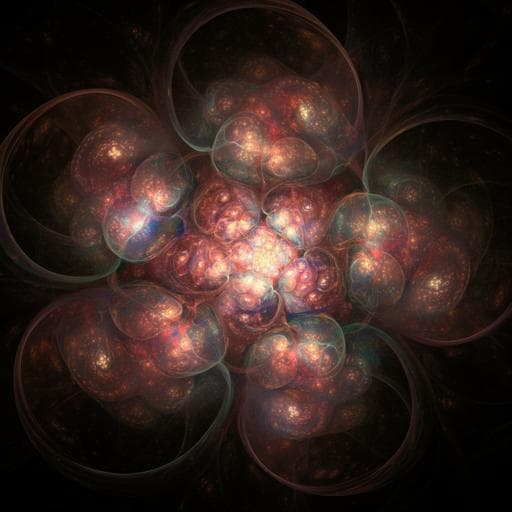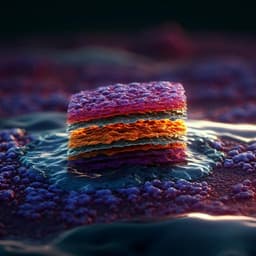
Physics
Two-qubit sweet spots for capacitively coupled exchange-only spin qubits
M. Feng, L. H. Zaw, et al.
Discover the future of quantum computation with groundbreaking research on high-fidelity two-qubit gates using semiconductor quantum dot qubits. Conducted by MengKe Feng, Lin Htoo Zaw, and Teck Seng Koh, this study reveals exact gate sequences and explores multiple sweet spots in parameter space, unveiling insights into noise thresholds critical for fault-tolerance. Join the journey toward revolutionizing quantum technologies!
~3 min • Beginner • English
Introduction
Semiconductor quantum dots are a leading platform for quantum computing due to scalability, long coherence, and compatibility with microelectronics. High-fidelity single- and two-qubit operations have been demonstrated in single, double, and triple quantum dot architectures. Exchange-only (EO) qubits encode logical states in the S=1/2, Sz=-1/2 doublet of three-electron spins, enabling fast, all-electrical single-qubit gates using exchange interactions and offering immunity to collective decoherence.
A central challenge is implementing high-fidelity two-qubit entangling gates. Two routes are exchange coupling (fast but short-ranged and with leakage risk) and capacitive coupling (electrostatic, longer-ranged, reduced leakage). Capacitive coupling lessens stringent addressability and mitigates leakage issues.
Here, the authors study two capacitively coupled EO qubits and provide exact gate sequences for CPHASE and CNOT, where the non-local operation occurs in a single time interval. Since charge noise in solid-state devices is ubiquitous and couples to electrical parameters, they model its effect assuming a 1/f spectrum and compute two-qubit gate fidelities and times. The work focuses on identifying and exploiting two-qubit sweet spots (2QSS)—points in parameter space where the two-qubit interaction is first-order insensitive to fluctuations—extending prior studies that considered 1QSS for AEON and RX and exchange-based 2QSS. They show 2QSS exist with respect to single-qubit parameters εm, τl, and τr in both qubits, enabling operation at single-parameter 2QSS, simultaneous two-parameter 2QSS (εm with τl or τr), or overlapping εm 2QSS with ε 1QSS (for RX/AEON with a specific tunnel coupling ratio). They discuss existence conditions, optimal working points, and fidelity optimization.
Literature Review
- Prior demonstrations established high-fidelity gates in single, double, and triple quantum dot systems, and EO qubits offer all-electrical control with decoherence-free encoding.
- Two-qubit operations using exchange coupling are fast but short-ranged and susceptible to leakage due to spin-conserving tunneling; capacitive coupling provides longer-range interactions with reduced leakage risk and relaxed addressability.
- Previous theoretical works proposed single-pulse exchange gates in certain limits and studied single-qubit sweet spots (1QSS) for AEON and RX qubits, as well as exchange-based two-qubit sweet spots.
- A gap remained regarding two-qubit sweet spots under capacitive coupling for EO qubits. This work addresses that by deriving and validating 2QSS for εm and tunnel couplings, and by providing exact capacitive two-qubit gate sequences.
Methodology
- System: Two exchange-only (EO) spin qubits encoded in triple quantum dots (TQDs) arranged linearly as two adjacent TQDs (qubit A: dots 1–3; qubit B: dots 4–6). Control parameters per TQD: left/right tunnel couplings (τl, τr) and detunings for outer and middle dots (ε, εm). A reflection symmetry between qubits is used for simulations.
- Single-qubit model: Start from a six-state basis per qubit consisting of two encoded (singly occupied) logical states and four states with one double occupation. Use a Hubbard Hamiltonian with nearest-neighbor tunneling Ht, on-site and inter-dot Coulomb Hu, and dot detunings Hε. In the perturbative regime (τ/U ≪ 1), perform a Schrieffer–Wolff transformation to obtain effective single-qubit Hamiltonians Heff ≈ (−ħω/2)σz − (ħg/2)σx, where ω and g depend on τl, τr, ε, εm, and Coulomb parameters. Logical states are “dressed” by charge admixtures whose amplitudes depend on electrical parameters.
- Two-qubit interaction: With no inter-TQD tunneling, inter-TQD Coulomb coupling Hint is diagonal in the computational basis with entries {V1,V2,V3,V4}. The ZZ-type nonlocal interaction (through differences in these energies) arises predominantly from dipole-dipole interactions of charge-admixed states (double-occupancy components). Inter-TQD Coulomb integrals Vij are computed analytically using 2D tri-quadratic confinement potentials with Fock–Darwin orbitals and Löwdin orthogonalization (material parameters for silicon used).
- Gate construction: Exact gate sequences for CPHASE and CNOT are provided. Using Makhlin invariants, the required non-local interaction time is t0 = kπ/[(V1+V4) − (V2+V3)] for odd integer k. Local single-qubit rotations are generated by Heff for each qubit.
- Noise model: Time-dependent parameter fluctuations added to ε, εm, τl, τr of each qubit: ñi(t)=ni+δηi(t). Uncorrelated, stationary, zero-mean Gaussian 1/f noise is simulated with power spectral density S(ω)=A2/ω for ωl≤ω≤ωh (roll-off at low frequency to avoid divergence). Separate detuning and tunneling noise cases are examined. Only the non-local interaction is taken as noisy; single-qubit gates are assumed ideal for most calculations.
- Fidelity evaluation: Non-local evolution with time-dependent Hint yields Uint(t0)=T exp{−i∫0^{t0} Hint(t)dt}. Gate fidelity is computed for the full exact sequences and averaged over many noise realizations. An approximate analytical average fidelity is derived via a cumulant expansion to second order in noise, yielding a closed-form expression in terms of noise variances, double-integrals of correlation functions, and linear combinations of Coulomb integrals. This enables identification of sweet spots via vanishing first derivatives of relevant interaction terms with respect to noisy parameters.
- Two-qubit sweet spots (2QSS): Define 2QSS as points where ∂Vi/∂nj=0 for a selected parameter nj, giving first-order insensitivity. Analytical conditions/lines for εm 2QSS and tunneling (τl, τr) 2QSS are derived; simultaneous double 2QSS (εm with τl or τr) are identified. There is no ε 2QSS in the linear geometry. Conditions for existence are provided (involving relative signs of Coulomb integrals and remaining within the (1,1,1) region).
- Parameters and numerics: Representative silicon parameters: on-site U=2.8 meV; nearest-neighbor inter-dot Coulomb U′=1.8 meV; next-nearest U″=0.9 meV; dot spacing R=160 nm; Bohr radius a=25 nm; εA=εB=0 for symmetry. AEON 1QSS at (ε=0, εm=U′−U″=−0.9 meV) independent of tunneling; RX working point at ε=0 (its ε 1QSS for symmetric tunneling) and εm≈−0.57 meV. Noise bandwidths used: ωl/2π≈66.7 kHz, ωh/2π≈50 GHz. Numerical simulations average over 500 (or 100 at very long gate times) noise realizations, recomputing charge admixtures and interaction terms at each time step.
Key Findings
- Exact capacitive two-qubit gate sequences: The paper presents explicit local+nonlocal pulse sequences for CPHASE and CNOT. The nonlocal interaction time is t0 = kπ/[(V1+V4)−(V2+V3)] (odd k), identical for both gates. The relevant energy difference is dominated by dipole-dipole interactions from doubly occupied charge admixtures.
- Two-qubit sweet spots (2QSS): Multiple families of 2QSS exist for each qubit with respect to εm, τl, and τr. Analytical lines/conditions are derived:
- εmA 2QSS (for qubit A) and εmB 2QSS (for qubit B) depend on tunnel-coupling ratio and specific Coulomb integrals (Eqs. analogous to (15), (16)). Their orientation in detuning space can be tuned by changing τl/τr.
- τl and τr 2QSS lines lie close to and parallel to the (1,2,0) and (0,2,1) boundaries, respectively, with linear relations Em = −ε − 2(U′−U″) or Em = ε − 2(U′−U″) (and corresponding expressions for qubit B). Intersections between εm and τl (or τr) lines yield double 2QSS.
- No ε 2QSS exists in the linear TQD geometry.
- Gate times: Nonlocal gate times are shortest near (1,1,1)-(1,0,2)/(2,0,1) boundaries (larger dipoles) and longest near (1,2,0)/(0,2,1) boundaries. With representative parameters, the fastest (k=1) gate times are ≈64 ns for RX and ≈450 ns for AEON. At εm–τl double 2QSS, gate times can be much longer (up to ~10–100 μs along tunneling 2QSS) and diverge at τl–τr double 2QSS (nonlocal gate conditions unsatisfied).
- Fidelity under 1/f noise: Numerical simulations (averaging over many noise realizations) agree well with an analytical cumulant-based fidelity formula, except that the analytical expression overestimates infidelity at double 2QSS where gate times become very long.
- Detuning vs tunneling noise: Infidelity is less sensitive to detuning noise than to tunneling noise at the same working point; derivatives of admixture squares with respect to detuning are suppressed relative to those for tunneling.
- Operating at εm 2QSS: Vertical line cuts show infidelity independent of σ(δεm), confirming protection. At εm–τl double 2QSS, infidelity is independent of both σ(δεm) and σ(δτl), confirming double protection.
- RX vs AEON: For comparable gate times (e.g., AEON k=1 at 450 ns and RX k=7 at ≈448 ns), AEON at its 1QSS shows slightly better fidelity (RX is more susceptible to charge noise despite stronger coupling). At RX’s fastest gate (k=1, 64 ns), RX outperforms AEON slightly, reflecting the general link between shorter gates and higher fidelities.
- Optimal working points:
- Intersections of εm 2QSS with τl 1QSS (achieved by setting arctan(τl/τr)≈57°) allow simultaneous 1QSS and 2QSS operation for both AEON and RX (with re-equalizing of τl=τr for RX’s single-qubit gates). For RX, further optimization can align its τl 1QSS with εm 2QSS at arctan(τl/τr)≈37.7°, giving t0≈198 ns.
- Global fidelity optimum with only detuning noise lies along εm 2QSS in the lower half of the (1,1,1) region, achieving extremely low infidelity (~10^−10 analytically and numerically). With only tunneling noise, the global optimum moves to the upper-right of (1,1,1) and infidelity increases significantly at the former optimum region, indicating competing noise sources and approximate additivity of infidelities.
- Fault tolerance implications: Meeting thresholds such as 1−F<10^−4 to 10^−6 requires extremely low noise, e.g., σε<10^−5 meV or στ<10^−5 meV. The best fidelities are achieved at εm–τl double 2QSS, but practicalities include longer t0 and precise timing needs.
Discussion
The work addresses the key challenge of high-fidelity two-qubit gates in EO qubits by introducing exact capacitive-gate sequences and identifying two-qubit sweet spots that render the nonlocal interaction first-order insensitive to charge-noise fluctuations in specific control parameters. By mapping out εm, τl, and τr 2QSS and their intersections, the authors demonstrate practical routes to operate at points combining protection (2QSS) with acceptable gate times, and even coincide with single-qubit sweet spots (1QSS) by tuning tunnel-coupling ratios. The analysis clarifies trade-offs: faster gates near charge boundaries improve fidelity via reduced exposure time but increase susceptibility to noise due to larger charge admixture; conversely, deeper in (1,1,1) reduces coupling and lengthens gates. The comparison between AEON and RX shows that while RX can be faster, its larger dipole enhances noise sensitivity; an optimal strategy can involve working at simultaneous εm 2QSS and τl 1QSS, retuning tunnel couplings between nonlocal and single-qubit operations. The analytical fidelity model, validated by simulations, offers insight into how different noise sources contribute and where sweet spot protection is effective. Global optimization depends on the dominant noise type and magnitude; with negligible tunneling noise, a global optimum on εm 2QSS can reach fault-tolerant fidelities, but realistic tunneling noise shifts this optimum. Practical considerations include pulse timing precision, potential correlated noise, and incorporating noisy single-qubit gates; nonetheless, the shared parameter space between single- and two-qubit gates suggests coordinated optimization is feasible.
Conclusion
This study provides exact capacitive CPHASE and CNOT gate sequences for exchange-only triple-dot qubits and demonstrates the existence and utility of multiple two-qubit sweet spots with respect to εm and tunnel couplings. It shows how εm 2QSS can be engineered to intersect with single-qubit sweet spots by tuning τl/τr, and identifies double 2QSS (εm with τl or τr) that further suppress sensitivity. With realistic parameters, RX can achieve ~64 ns gates (k=1) and AEON ~450 ns, with fidelity advantages aligning with shorter gate times. Analytical and numerical fidelity analyses under 1/f noise indicate that detuning noise is less harmful than tunneling noise, that the best protected points lie on εm 2QSS, and that meeting strict fault-tolerance thresholds requires very low noise levels. Future work should include experimental validation of capacitive 2QSS, characterization of multi-parameter and correlated noise spectra, incorporation of noisy single-qubit gates and optimal control, device-specific potential modeling, and exploration of architectures minimizing tunneling noise while maintaining strong capacitive coupling.
Limitations
- Assumes weak, stationary, Gaussian 1/f noise with a low-frequency roll-off; correlated noise and non-Gaussian effects are not modeled.
- Single-qubit gates are treated as ideal (noiseless) for most analyses; in practice, their noise will contribute to total infidelity.
- Perturbative Schrieffer–Wolff treatment presumes τ/U ≪ 1 and operation in the (1,1,1) regime; accuracy may degrade near charge boundaries.
- Capacitive coupling modeled with 2D tri-quadratic potentials and specific silicon parameters; device-to-device variations and 3D effects are not fully captured.
- Double tunneling 2QSS yields divergent t0 (nonlocal gate infeasible), limiting practical exploitation of some sweet-spot intersections.
- Analytical fidelity overestimates infidelity at double 2QSS where gate times are long, reflecting limitations of the approximation.
- No ε 2QSS exists in the linear geometry, leaving sensitivity to outer-dot detuning noise unmitigated by sweet spots.
Related Publications
Explore these studies to deepen your understanding of the subject.







